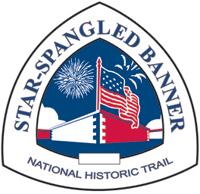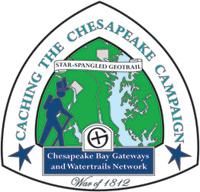SSB - Dumbarton House Museum Traditional Geocache
SSB - Dumbarton House Museum
-
Difficulty:
-

-
Terrain:
-

Size:  (regular)
(regular)
Related Web Page
Please note Use of geocaching.com services is subject to the terms and conditions
in our disclaimer.
During the first challenge along the Star-Spangled Banner GeoTrail, over 400 first edition SSB geocoins were awarded. We would like to thank everyone who participated in the Star-Spangled Banner GeoTour. We are currently out of geocoins but stay tuned for other opportunities along the Star-Spangled Banner GeoTour!


Come on a journey to remember and commemorate the dramatic chain of events, people and places that led to the birth of our National Anthem.
The story of the Star-Spangled Banner was shaped by the events of the Chesapeake Campaign during the War of 1812. From February 1813 until February 1815, the Chesapeake Bay was the center of a fierce struggle between the British and Americans. Places and landscapes still exist today that provide a touchstone to the past. The trail traces events and related sites that figured prominently in the Chesapeake Campaign of the War of 1812 that have national significance, physical integrity, and the potential for contemporary recreation and interpretation.

South facade before restoration, 1931
© Harris and Ewing, Washington, DC
You are seeking a traditional hide. The cache is available 7 days per week and there is limited free parking located behind the house. Please be respectful of the gardens. If there is an event in progress, please be considerate when retrieving the cache.
The Dumbarton House is open for tours Tuesday – Sunday. Please refer to www.dumbartonhouse.org for a complete list of current events and times.
Situated in the Georgetown neighborhood of Washington, D.C., Dumbarton House is a fine example of Federal period architecture and offers visitors to the capital city a unique perspective on early American history. The property was built on a large tract of land patented in 1703 by an immigrant from Scotland, Ninian Beall, who named the land "Rock of Dumbarton” in tribute to his homeland. In 1798, developer Samuel Jackson bought 4.5 acres of "Rock of Dumbarton" and began to construct the property that eventually became known as "Cedar Hill." Although construction began in approximately 1799, work was halted when Jackson went bankrupt. Not having an intended owner for the house, it went up for public auction, and eventually was acquired by Joseph Nourse, first Register of the U.S. Treasury. Nourse completed construction of the home and he and his family lived at "Cedar Hill" from 1804-1813.
In 1813, during the midst of the War of 1812, the home was bought and renamed "Belle Vue" by Charles Carroll, a wealthy relation of Maryland’s Charles Carroll of Carrollton, the only Catholic signer of the Declaration of Independence. On August 24, 1814, Belle Vue would host, if only for a few hours, its’ most famous guest - First Lady Dolley Madison.
Fearing the imminent arrival of British forces in Washington, Madison made haste to flee the White House that afternoon. Before leaving, however, she was certain to save Gilbert Stuart’s famous portrait of George Washington that now hangs in the East Room. She was assisted in this task by Jean-Pierre Sioussat, a French steward, and enslaved African Americans including Magraw, a gardener, and Paul Jennnings, who would go on to write, A Colored Man's Recollections of James Madison (1867). According to many historians, it was likely these men who took the painting down and sent it off by wagon with some large silver urns and other valuables. Having thus secured the work of art, the First Lady made her way to the heights of Georgetown in a Carroll family carriage and remained at Dumbarton House for a few hours while waiting for instructions from her husband, President James Madison, who had been out in the field observing the American’s defeat at the Battle of Bladensburg.
Dolley Madison described the events of the day to her sister in a letter, “Our kind friend, Mr. Carroll, has come to hasten my departure, and is in a very bad humour with me because I insist on waiting until the large picture of General Washington is secured, and it requires to be unscrewed from the wall. This process was found too tedious for these perilous moments; I have ordered the frame to be broken, and the canvas taken out. It is done! and the precious portrait placed in the hands of two gentlemen from New York, for safekeeping…And now, dear sister, I must leave this house, or the retreating army will make me a prisoner in it by filling up the road I am directed to take. When I shall again write to you, or where I shall be tomorrow, I cannot tell!” From the Dolley Madison Papers, Manuscript Division, The Library of Congress, via www.dumbartonhouse.org
It was fortunate that Dolley Madison escaped, for her home was burned by the British that evening. The presidential mansion [not yet called the “White House”] was utterly destroyed, left a roofless shell by the invaders. It was rebuilt in 1817 and repainted or “white washed,” though it did not acquire the name “White House” until the first years of the 20th century. If you look close enough though, some scorch marks are still visible on the sandstone blocks forming the entrance arch to the kitchen immediately below the north portico on the west side facing Pennsylvania Avenue.

Today, Dumbarton House serves as headquarters for the National Society of The Colonial Dames of America. The NSCDA purchased the house in 1928 and restored it to its early 19th century character, changing the house’s name to "Dumbarton House." Each August, to honor the First Lady’s flight from the White House, Dumbarton House celebrates Dolley at Dumbarton. The annual Family Festival includes food, children’s activities and special tours. You can also see the museum’s significant collection of Federal decorative arts, paintings, and furniture. Dolley’s thank you gift, reportedly a crystal bowl, is among the items on display.

Thanks to WWCD for helping with this hide and to the Maryland Geocaching Society for assisting with this project!
Additional Hints
(Decrypt)
haqre gur obk jbbq arne gur erne fgnvef